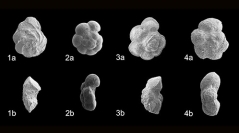

 Comptes Rendus Palevol
2 (6-7) - Pages 587-595
Comptes Rendus Palevol
2 (6-7) - Pages 587-595During the Cenomanian–Turonian boundary, the anoxic event OAE2 has involved the disappearance of Rotalipora , complex keeled planktonic foraminifera which had conquered deep oceanic water. In the Western Interior basin, the last rotalipores are associated with Anaticinella, morphotypes without keel. The heterochronical relationship between these morphotypes is investigated. The loss of the keel would be a selective advantage enabling them to remain in the surface water, less reached by oceanic anoxia. Thus, two endemic species, only known in the American seaway, are observed: A. multiloculata (Morrow) and A. planoconvexa (Longoria). These species would respectively result by neoteny from R. greenhornensis and R. cushmani.
planktic foraminifera, Cenomanian–Turonian, Western Interior Basin (USA), ontogenetic heterochronies, Oceanic Anoxic Event